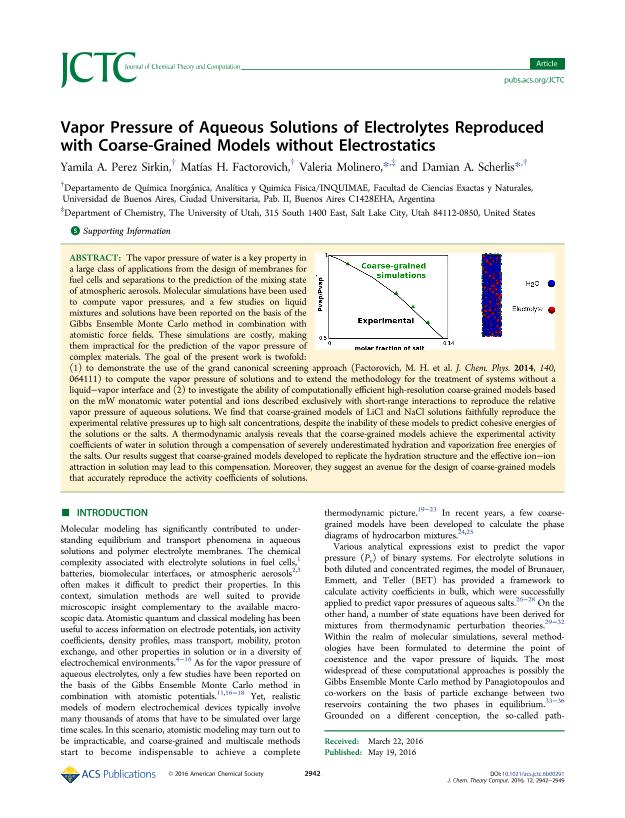Mostrar el registro sencillo del ítem
dc.contributor.author
Pérez Sirkin, Yamila Anahí

dc.contributor.author
Factorovich, Matias Hector

dc.contributor.author
Molinero, Valeria
dc.contributor.author
Scherlis Perel, Damian Ariel

dc.date.available
2018-05-30T15:04:59Z
dc.date.issued
2016-05
dc.identifier.citation
Pérez Sirkin, Yamila Anahí; Factorovich, Matias Hector; Molinero, Valeria; Scherlis Perel, Damian Ariel; Vapor pressure of aqueous solutions of electrolytes reproduced with coarse-grained models without electrostatics; American Chemical Society; Journal of Chemical Theory and Computation; 12; 6; 5-2016; 2942-2949
dc.identifier.issn
1549-9618
dc.identifier.uri
http://hdl.handle.net/11336/46607
dc.description.abstract
The vapor pressure of water is a key property in a large class of applications from the design of membranes for fuel cells and separations to the prediction of the mixing state of atmospheric aerosols. Molecular simulations have been used to compute vapor pressures, and a few studies on liquid mixtures and solutions have been reported on the basis of the Gibbs Ensemble Monte Carlo method in combination with atomistic force fields. These simulations are costly, making them impractical for the prediction of the vapor pressure of complex materials. The goal of the present work is twofold: (1) to demonstrate the use of the grand canonical screening approach (Factorovich, M. H. et al. J. Chem. Phys. 2014, 140, 064111) to compute the vapor pressure of solutions and to extend the methodology for the treatment of systems without a liquid−vapor interface and (2) to investigate the ability of computationally efficient high-resolution coarse-grained models based on the mW monatomic water potential and ions described exclusively with short-range interactions to reproduce the relative vapor pressure of aqueous solutions. We find that coarse-grained models of LiCl and NaCl solutions faithfully reproduce the experimental relative pressures up to high salt concentrations, despite the inability of these models to predict cohesive energies of the solutions or the salts. A thermodynamic analysis reveals that the coarse-grained models achieve the experimental activity coefficients of water in solution through a compensation of severely underestimated hydration and vaporization free energies of the salts. Our results suggest that coarse-grained models developed to replicate the hydration structure and the effective ion−ion attraction in solution may lead to this compensation. Moreover, they suggest an avenue for the design of coarse-grained models that accurately reproduce the activity coefficients of solutions.
dc.format
application/pdf
dc.language.iso
eng
dc.publisher
American Chemical Society

dc.rights
info:eu-repo/semantics/openAccess
dc.rights.uri
https://creativecommons.org/licenses/by-nc-sa/2.5/ar/
dc.subject
Vapor Pressure
dc.subject
Solutions
dc.subject
Thermodynamics
dc.subject.classification
Otras Ciencias Químicas

dc.subject.classification
Ciencias Químicas

dc.subject.classification
CIENCIAS NATURALES Y EXACTAS

dc.title
Vapor pressure of aqueous solutions of electrolytes reproduced with coarse-grained models without electrostatics
dc.type
info:eu-repo/semantics/article
dc.type
info:ar-repo/semantics/artículo
dc.type
info:eu-repo/semantics/publishedVersion
dc.date.updated
2018-05-28T14:40:30Z
dc.journal.volume
12
dc.journal.number
6
dc.journal.pagination
2942-2949
dc.journal.pais
Estados Unidos

dc.journal.ciudad
Washington DC
dc.description.fil
Fil: Pérez Sirkin, Yamila Anahí. Consejo Nacional de Investigaciones Científicas y Técnicas. Oficina de Coordinación Administrativa Ciudad Universitaria. Instituto de Química, Física de los Materiales, Medioambiente y Energía. Universidad de Buenos Aires. Facultad de Ciencias Exactas y Naturales. Instituto de Química, Física de los Materiales, Medioambiente y Energía; Argentina
dc.description.fil
Fil: Factorovich, Matias Hector. Consejo Nacional de Investigaciones Científicas y Técnicas. Oficina de Coordinación Administrativa Ciudad Universitaria. Instituto de Química, Física de los Materiales, Medioambiente y Energía. Universidad de Buenos Aires. Facultad de Ciencias Exactas y Naturales. Instituto de Química, Física de los Materiales, Medioambiente y Energía; Argentina
dc.description.fil
Fil: Molinero, Valeria. University of Utah; Estados Unidos
dc.description.fil
Fil: Scherlis Perel, Damian Ariel. Consejo Nacional de Investigaciones Científicas y Técnicas. Oficina de Coordinación Administrativa Ciudad Universitaria. Instituto de Química, Física de los Materiales, Medioambiente y Energía. Universidad de Buenos Aires. Facultad de Ciencias Exactas y Naturales. Instituto de Química, Física de los Materiales, Medioambiente y Energía; Argentina
dc.journal.title
Journal of Chemical Theory and Computation

dc.relation.alternativeid
info:eu-repo/semantics/altIdentifier/url/http://pubs.acs.org/doi/abs/10.1021/acs.jctc.6b00291
dc.relation.alternativeid
info:eu-repo/semantics/altIdentifier/doi/http://dx.doi.org/10.1021/acs.jctc.6b00291
Archivos asociados
